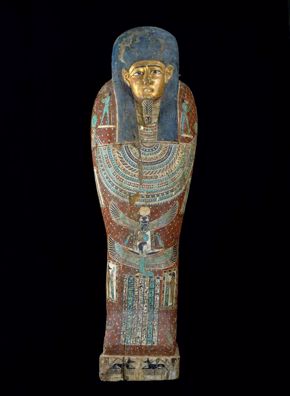Practice Looking at Art
Engaging with a work of art is a meaningful and lasting experience. This four-step process encourages close looking and careful thinking with any work of art, whether viewed in the Museum, in the classroom, or at home.
The Four-Step Process

Egyptian, Coffin of Pedi-Osiris, 305 BC–AD 30, carved and painted wood and gold, the Museum of Fine Arts, Houston, Museum purchase funded by the Alice Pratt Brown Museum Fund.
Subodh Gupta, Untitled, 2008, stainless steel, the Museum of Fine Arts, Houston, Museum purchase funded by the Caroline Wiess Law Accessions Endowment Fund and Friends of Asian Art. © Subodh Gupta, courtesy Hauser & Wirth, London
John Biggers, Jubilee: Ghana Harvest Festival, 1959–63, tempera and acrylic on canvas, the Museum of Fine Arts, Houston, Museum purchase funded by Duke Energy. © John T. Biggers Estate/Licensed by VAGA, New York, NY, Estate Represented by Michael Rosenfeld Gallery
Akan, Ghana, Linguist Staff with Finial Representing an Elephant, 1885–95, wood and gold leaf, the Museum of Fine Arts, Houston, gift of Alfred C. Glassell, Jr.
Georgia O’Keeffe, Red Hill and White Shell, 1938, oil on canvas, the Museum of Fine Arts, Houston, gift of Isabel B. Wilson in memory of her mother, Alice Pratt Brown. © Georgia O’Keeffe Museum / Artists Rights Society (ARS), New York
Aztec, Mexico, Standard-Bearer, 1200–1519, igneous rock, the Museum of Fine Arts, Houston, gift of D. and J. de Menil.
Louis Comfort Tiffany, A Wooded Landscape in Three Panels, c. 1905, glass, copper-foil, and lead, the Museum of Fine Arts, Houston, Museum purchase funded by the Brown Foundation Accessions Endowment Fund.
Roman, The Indian Triumph of Dionysus, late 2nd century AD, marble, the Museum of Fine Arts, Houston, Museum purchase funded by Lee and Joe Jamail in honor of Caroline Wiess Law.
Assyrian, Guardian Figure, 883–859 BC, gypsum, the Museum of Fine Arts, Houston, Museum purchase funded by the Agnes Cullen Arnold Endowment Fund.
Claude Monet, Water Lilies (Nymphéas), 1907, oil on canvas, the Museum of Fine Arts, Houston, gift of Mrs. Harry C. Hanszen.
Indian, Shiva Nataraja, 13th century, bronze, the Museum of Fine Arts, Houston, gift of Carol and Robert Straus.
Marsden Hartley, Abstraction, c. 1914, oil on paperboard, mounted on panel, the Museum of Fine Arts, Houston, gift of Mr. and Mrs. Ralph O'Connor in honor of Mr. and Mrs. George R. Brown.
Jacques-Raymond Brascassat, A Bull Fight, 1855, oil on canvas, the Museum of Fine Arts, Houston, Museum purchase funded by Fayez Sarofim in honor of Meredith J. Long at “One Great Night in November, 1991.”
1. LOOK
Take time to look at the work of art.
- Encourage students to take in the entire work of art, paying close attention to details. Ask the question, “What do you notice?” and encourage students to take inventory of everything they see.
- Instruct students to look at a work of art for 30 seconds, and then to turn around and try to remember everything they observed. When they are looking at the work of art again, ask them about the details that they remember. What did they overlook?
2. DESCRIBE
Talk about what you see in the work of art.
- Encourage students to describe all of the things that they see. Explore line, shape, color, composition, material, and subject matter.
- Instruct students to use expressive language to describe what they see in detail. For example, instead of saying, “I see the sky,” they could say, “I see a dark, foreboding sky full of heavy clouds that sulk across the composition.”
3. THINK
Interpret and assign meaning to the work of art.
- Discuss the following with your students:
- What story is taking place? What is the setting, or the time and place depicted?
- What is the mood of the work? How do you know?
- What is this work of art about?
- What do you think the artist was trying to communicate through the creation of this work of art?
4. CONNECT
Relate what you see to your own life, or to other works of art or images you have seen.
- Discuss the following with your students:
- What does this work of art remind you of? Why?
- How does this work of art relate to an aspect of your own life?
- Compare this work of art to other images/objects that you have seen, either in a museum or in your everyday life. How are they similar? How are they different?
Test it out! Choose a work of art from the slideshow above, and use the strategies of LOOK, DESCRIBE, THINK, and CONNECT as you look closely with your students.
